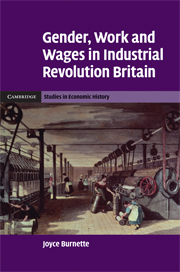Book contents
- Frontmatter
- Contents
- List of figures
- List of tables
- Preface
- Introduction
- 1 Women's occupations
- 2 Women's wages
- 3 Explaining occupational sorting
- 4 Testing for occupational barriers in agriculture
- 5 Barriers to women's employment
- 6 Occupational barriers in self-employment
- 7 Women's labor force participation
- 8 Conclusion
- Appendix to Chapter 3
- Appendix to Chapter 4
- Bibliography
- Index
3 - Explaining occupational sorting
Published online by Cambridge University Press: 07 August 2009
- Frontmatter
- Contents
- List of figures
- List of tables
- Preface
- Introduction
- 1 Women's occupations
- 2 Women's wages
- 3 Explaining occupational sorting
- 4 Testing for occupational barriers in agriculture
- 5 Barriers to women's employment
- 6 Occupational barriers in self-employment
- 7 Women's labor force participation
- 8 Conclusion
- Appendix to Chapter 3
- Appendix to Chapter 4
- Bibliography
- Index
Summary
Two circumstances – permanent inferiority of strength, and occasional loss of time in gestation and rearing of infants – must eternally render the average exertions of women in the race of the competition for wealth less successful than those of men.
William Thompson, An Appeal, 1825The previous two chapters have documented large gender differences in wages and occupations. These differences are well known and easy to document, but explaining why these differences occurred is a more difficult task. Most historians attribute occupational sorting by gender to some form of discrimination. However, this conclusion is too hasty if we have not first explored whether a non-discriminatory labor market would produce the observed results. This chapter will present some models of market-based occupational sorting, and will argue that in the most competitive parts of the labor market the division of labor between the sexes matched would have been produced by the market.
In the last chapter we saw that sex differences in wages could be explained by differences in productivity. Of course, discrimination could still be the cause of women's low wages if gender discrimination confined women to a limited number of occupations, where their productivity was low. One way to explain the observed occupational sorting and wage differences is the crowding hypothesis formulated by Barbara Bergmann.
- Type
- Chapter
- Information
- Gender, Work and Wages in Industrial Revolution Britain , pp. 136 - 185Publisher: Cambridge University PressPrint publication year: 2008



